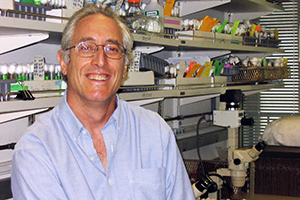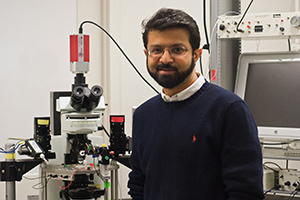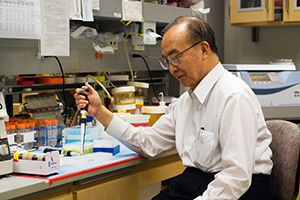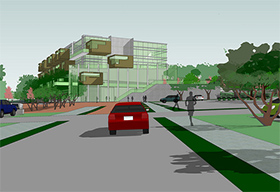|
A New Era In Stem Cell Research
Researchers Hail New Presidential Order on Stem Cell Work, Increased Scientific Funding
Ioana Patringenaru | March 30, 2009
Scientists could expand their investigations and make new discoveries. Laboratories could get more equipment. A new building dedicated to stem cell research could get a boost. UC San Diego stands to reap significant benefits from an executive order signed by President Barack Obama this month lifting certain federal restrictions on stem cells research and from money earmarked for research in the federal stimulus package that became law last month.
“It will be a huge boost,” said Larry Goldstein, director of UCSD’s stem cell research program. “It will make a big difference.”

Larry Goldstein is the director of UCSD's stem cell research program.
On March 9, President Obama signed an executive order that lifted restrictions on federal funding for stem cell research that had been in effect since August 2001. Under the old rules, scientists could only use federal funds to work on a small number of existing human embryonic stem cell lines, or colonies. But researchers couldn’t use federal funding to study lines created since the rules came into effect. Now, they will be able to apply for federal grants to work on cells from wider variety of sources.
In addition, on Feb. 17, President Obama signed into law the American Recovery and Reinvestment Act, which provides $10.4 billion to the National Institutes of Health (NIH), all available for two years—through September 2010, according to the U.S. Department of Health and Human Services. Most of the money will go to research and some of it will now be available for stem cell studies. In addition, the stimulus package also sets aside $3 billion for the National Science Foundation for the 2009 fiscal year.
Goldstein, the stem cell program director, cautioned it will take 120 days for the changes ordered by the Obama administration to take effect. During that time, the NIH will draft new guidelines for stem cell research. The goal is, for example, to make sure that blastocysts used for research have been acquired appropriately. “As scientists, we welcome appropriate regulation,” Goldstein said. “We are not a bunch of cowboys.”
Researchers will now be able to use federal funds and grants to explore a wide variety of ideas when working with human embryonic stem cells, he said. This will considerably stimulate discovery, he added. Meanwhile, federal stimulus funds will give a badly needed boost to research funding, Goldstein said. In recent years, federal spending on bio-medical research has remained flat while inflation rose—the equivalent of a cut, he also said.
“Fundamentally, the stimulus will put gas in the tank,” Goldstein said.
In the lab
So far, most stem cell research in California has been funded by private funds and by the California Institute for Regenerative Medicine, the state entity that doles out the $3 billion in stem cell research funding voters approved in 2004. But, historically, CIRM funding has been targeted to specific areas, such as facilities, disease teams or basic science, said UCSD neurobiologist Anirvan Ghosh. By contrast, NIH grants give investigators more leeway to decide which research areas they want to pursue. “This will have a catalytic effect,” he said.

Neurobiologist Anirvan Ghosh said he plans to apply for a NIH grant funded by the federal stimulus package.
Ghosh is at the helm of a laboratory that studies the development of the human cortex and how neurons and synapses form in that part of the brain. Human stem cells can be turned into neurons and used as models that allow researchers to observe their development, Ghosh explained.
Stem cells also can be used to model brain cells affected by certain diseases, such as Alzheimer’s, on which different drugs could be tested. Ghosh explained that he and colleagues were particularly interested in finding out what keeps synapses, the connections between neurons, stable. Research has shown that in Alzheimer’s disease, a loss of synapses precedes a loss of neurons.
For the past two years, Ghosh’s team has been working on newer stem cell lines under a grant from CIRM, the California-funded stem cell research agency. It ends this summer. The combination of the Obama executive order and the stimulus moneys means that researchers will now be able to apply for NIH grants. A standard grant would add up to $250,000, but the new federal grants allow researchers to apply for up to $1 million over two years. Ghosh’s team is considering accelerating its research to include not only a study of synapse loss, but also drug screening to slow down the process.
“At a practical level, it has a huge impact,” he said of the new funding.
Other grants
The NIH also will be offering supplemental grants, which will allow researchers to add one employee to their lab, as well as new equipment and supplies, said renowned UCSD bioengineer Shu Chien. These grants might be the easiest to get, he added.
Chien has worked with Karl Willert, director of UCSD’s stem cell core facility, to develop an automated, computerized process that allows scientists to identify the best environments to grow stem cells. The experiments require mixing six proteins in a wide range of combinations. The machine developed by Chien’s team allows researchers to test hundreds of them at once.

Bioengineer Shu Chien and colleagues designed an innovative method to identify the best environments for stem cells growth.
With UCSD bioengineer Adam Engler and material science professor Shungho Jin, Chien also examines how the physical properties of the environments where stem cells grow can influence their development. For example, a stiffer matrix can steer the cells toward becoming more like bone cells, while a softer matrix leads to brain-like ones, Chien explained.
He added that many UCSD researchers working in a wide variety of fields, not just stem cells, could benefit from two other types of NIH grants included in the stimulus package. Instrumentation moneys allow labs to apply for up to $8 million in equipment. Chien and his colleagues are considering purchasing a multi-million dollar high-resolution microscope, which can be used to observe live cells in motion. Grants for renovation also could serve many campus departments, Chien said.
“It’s a once-in-a-lifetime opportunity,” he said. “It will never happen again.”
Campuswide changes
At UCSD, the Obama executive order also means that a number of federally-funded facilities with state-of-the-art equipment will now no longer be off-limits to many research projects. After President George W. Bush restricted the number of cell lines on which federal funds could be used, UCSD set up a shared core campus facility where researchers could work on non-approved lines in an environment free of federal funds. The facility was used to train researchers across disciplines and give them an opportunity to interact.
Researchers also will have a lot less paperwork to deal with. The university, like most large academic institutions, always has been adept at keeping track of different funding sources for different projects, said Goldstein, the stem cells program director. In his lab, which receives primarily state and private funds, that has mostly meant keeping track of salaries, not small supplies and other minutia. “You don’t have to track the money down to the pen,” he said.
In addition, the campus has established an oversight committee co-chaired by Vice Chancellor for Research Art Ellis and Goldstein to make sure that federal guidelines are followed in all departments, from research to purchasing. Goldstein said he hopes the role of the body will now be diminished.
A new stem cell research facility

The investment of $43 million from CIRM and $112 million from donors and institutions will fund the construction of a buiilding to house the Sanford Consortium for Regenerative Medicine, a collaboration between UCSD, the Salk Institute for Biological Studies, The Scripps Research Institute and the Burnham Institute for Medical Research.
Courtesy of the California Institute for Regenerative Medicine
UCSD also has joined forces with three other institutions on the Torrey Pines Mesa to build a new facility dedicated to stem cell research. The Sanford Consortium for Regenerative Medicine needs an additional $71 million to finish the facility, said consortium president Edward Holmes, a former dean of UCSD’s School of Medicine. Consortium officials will pursue federal funding for the building, he said, either directly from stimulus funds, or from NIH funds earmarked for facilities.
The energy-efficient 100,000-square-foot, four-story facility would house a majority of UCSD researchers in a wide range of disciplines, as well as scientists from The Scripps Research Institute, the Burnham Institute for Medical Research and the Salk Institute for Biological Studies, Holmes said. UC Regents approved the environmental impact report for the project in November 2008 and the California Coastal Commission granted a development permit in January of this year. The project is now “shovel-ready,” Holmes said—pending funding.
Holmes added he believes UCSD researchers will do well in securing new federal funding for their projects. San Diego is the third-ranked city in the nation terms of NIH funding, he pointed out.
“That speaks volumes to the quality of the science taking place here,” he said.

|